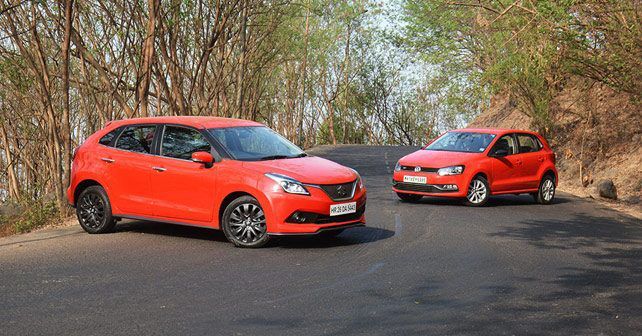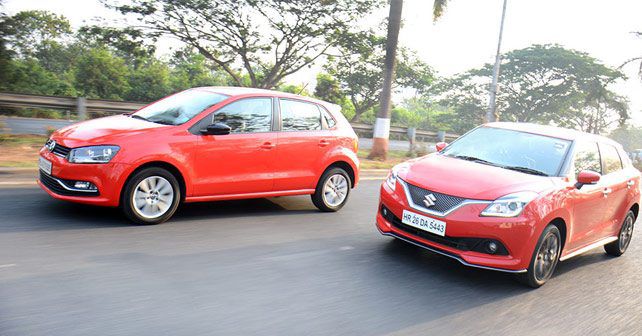Here are two cars that can satiate a car enthusiast’s hunger for performance while doubling up as family cars. But which is better?
Talk to petrolheads about their aspirations, and you can almost always imagine them in a dreamy state with pictures of sleek sports cars in their thought bubbles. But, when reality strikes and a sense of viability hits, those thoughts vanish into thin air. More often than not, enthusiasts are forced to hunt for a car that not only offers space and practicality, but also one that won’t require them to sell a kidney to own. Yet, it should remain exciting to drive. Now all that is easier said than done!
Turn the clock back 15 years, and there weren’t many such products on the market except for the 100bhp Fiat Palio. Thankfully, that’s no longer the case. Buyers now have more than one option to choose from. Of course, the Volkswagen Polo GT TSI is one of them, but now there’s also the Maruti Suzuki Baleno RS. So, is the new kid on the block exciting and versatile enough to meet the high demands of enthusiasts more persuasively than the GT TSI?
The Volkswagen Polo GT TSI and the Maruti Suzuki Baleno RS are punchier versions of their respective namesakes. Apart from the need for a powerful motor, enthusiasts also want their car to be easily distinguished from their run-of-the-mill brethren. In that regard, the Baleno RS easily pips its rival. The RS has plenty to set itself apart from the standard model. The black bezel headlamps, the sportier front bumper with a lip spoiler, side skirts, gloss black alloy wheels and plastic-clad rear bumper all play their part in giving the Baleno RS a sportier stance.
In comparison, the Polo GT TSI doesn’t have as many differentiating factors – save for the gloss black treatment to the ORVMs and rear spoiler, blacked-out headlamps and slightly different alloy wheels. That being said, while looks are a matter of personal opinion, to me, the eight-year-old design of the Polo with its clean lines still looks better than the Baleno RS.
On the inside, both cars are exactly the same as their less powerful counterparts – which comes as a disappointment. We would have loved to see at least some additional badging and added bolstering on the seats at the very least. The grainy finish on the Polo’s dashboard doesn’t look as premium as the Baleno, but in terms of build quality the former is definitely superior. The plastics on the dashboard and door panels are sturdy and built to last. What the Baleno RS loses out in terms of quality, it more than makes up for in practicality. The Maruti Suzuki offering is longer, wider and taller than the Volkswagen, which means there’s more room on the inside. The Polo GT TSI has a huge transmission tunnel (presumably for its European All Wheel Drive version), which robs the cabin of a lot of space. Moreover, at 339 litres, the Baleno RS has 44 litres more of boot space than the Polo GT TSI.
And the Baleno clearly has a longer list of features. It gets projector headlamps, a reversing camera, button-start and keyless go – all of which is missing from the Polo GT TSI. Common features include climate control, electrically adjustable ORVMs, and, with regards to safety, ABS and airbags. By virtue of it being an automatic, the GT TSI also gets hill-hold and traction control. Our test Polo GT TSI wasn’t equipped with a touchscreen infotainment system, but the newer models come fitted with one.
The Polo’s front seats are undoubtedly better than the Baleno’s. For one, they are snug and amply supportive – and the relatively firm cushioning means better comfort while driving for long hours. I prefer the higher driving position in the Polo, as it provides a better view of the road ahead and gives the driver a commanding position from behind the wheel – which is in contrast to the relatively low driving position of its rival.
Now that we have the aesthetics and ergonomics out of the way, let’s get to the meat of the matter. While the Baleno and the Polo have been fitted with turbocharged engines and produce more or less similar power figures – 101bhp and 103bhp respectively, they have two major differences that simply cannot be ignored. The Baleno displaces 998cc from a three-pot motor while the Polo’s 1,198cc engine is a four-cylinder unit. And then there’s the transmission – the Baleno comes mated to a 5-speed manual transmission, while the Polo’s engine has been paired with a 7-speed DSG. Despite these differences, though, it’s the nature of these cars that brings them together in this comparison.
From behind the wheel, the Baleno RS feels marginally quicker off the line – which has a lot to do with its 950kg weight, which is a full 159kgs less than the Polo GT TSI. That being said, there is a feeling of it being just a wee bit hesitant as you dump the clutch and get on the power – but this hesitation quickly disappears once you cross the 1,700rpm mark and the 150Nm of torque kicks in. From that point on, it remains eager right up till its 6,000rpm redline. To get the best out of the Baleno RS though, you do have to keep it in the meat of its powerband. Fortunately, the light clutch and smooth shifting gearbox adds some excitement to the drive. Of course, being a three-cylinder motor, it does get a bit noisy as the revs climb – but that in itself is more enjoyable than annoying.
On the other hand, the Polo GT TSI is quite the contrast. It does everything so effortlessly that it actually takes you by surprise. Want to make a quick overtake?
No problem, just flex your foot on the right pedal and it’s done! The 175Nm of torque really comes in handy in such situations, and the fact that it kicks in from as low as 1,500rpm makes it an absolute blast. Of course, the 7-speed DSG further makes the drive even easier – paddle shifters would have made it a lot more engaging though. The shifts are absolutely seamless, even when you slot it in M and take control of the gearbox. And then, of course, being a four-cylinder motor, it’s clearly more refined than the Baleno. Plus, being German, it does feel more at ease at high speeds than the Baleno.
Show both cars a mountain road, and you’re sure to feel more confident in the Polo GT TSI. There is a bit of body roll, the steering isn’t as communicative as we would have liked, but despite that the Polo feels better planted. It turns in well and shifts when you want it to, leaving you to just focus on your lines. It’s very much a point-and-shoot kind of machine!
Keeping in mind the feedback that Maruti Suzuki has received since the Baleno’s launch, they have made some changes to the RS. These changes will later be carried forward to the standard model as well. The chassis has been updated for improved crash protection, and the suspension too has been stiffened a little. Despite that, the Baleno feels softer than the Polo, which leads to more lateral movement and a somewhat unsettling drive out of bumpy corners. On the flipside, the relatively softer setup results in better ride quality. But the steering felt a bit too light for our liking.
And while you would assume that the addition of rear discs on the Baleno RS would result in better braking prowess, that isn’t quite the case. Despite being fitted with a drum setup at the back, the Polo GT TSI has plenty of bite.
The two big aspects that work in favour of the Maruti Suzuki Baleno are fuel efficiency and price. While enthusiasts tend to focus more on the way a car drives, fuel efficiency is generally not ignored in India. The Baleno RS claims an ARAI rated fuel efficiency of 21.1kmpl, which is noticeably higher than the Polo GT TSI’s claimed 17.21kmpl. As far as pricing is concerned, the Baleno RS is priced at Rs. 8.69 lakh while the Polo GT TSI carries a price tag of Rs. 9.31 lakh (ex-showroom, Delhi). Here it’s important to keep in mind that the stark difference in price and fuel efficiency can be contributed to the GT TSI being an automatic.
So, if you’re on the lookout for a performance hatchback that looks different from the standard model, is affordable to maintain and makes reasonable power without compromising on comfort, then the Baleno RS is what you should choose. But while the Baleno wins out in terms of space and comfort, there’s no denying that the Polo is clearly the more focussed driver’s car of this duo. It’s effortless in the way it performs. It also comes fitted with what is among the best automatic gearboxes in the business, which earns it more brownie points. The Polo GT TSI doubles up as a stress-free daily drive while also fulfilling the need for speed – making it the real choice for the enthusiast.
Also read- Abarth Punto vs Volkswagen Polo GT TSI: Comparison
- Volkswagen Polo GT TSI
- Maruti Suzuki Baleno RS
Engine: 1,198cc / 4-cylinders / 16 Valves / Turbocharged
Fuel: Petrol
Transmission: 7-speed DSG / Front-wheel drive
Power: 103bhp @ 5,000rpm
Torque: 175Nm @ 1,500rpm
Price: 9.31 lakh (Ex-showroom, Delhi)
X-Factor: Great powertrain that gives you the convenience of an automatic with a splash of performance – frankly, it’s all you need on our roads.
Engine: 998cc / 3-cylinder / 12 Valves / Turbocharged
Fuel: Petrol
Transmission: 5-speed manual / Front-wheel drive
Power: 101bhp @ 5,500rpm
Torque: 150Nm @ 1,700–4,500rpm
Price: Rs. 8.69 lakh (Ex-showroom, Delhi)
X-Factor: Does affordable, practical and comfortable very well indeed. Meanwhile, speed is improved – but doesn’t quite go far enough.




























Write your Comment